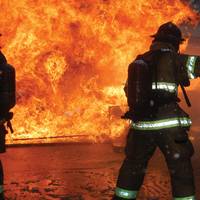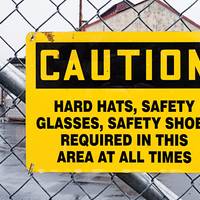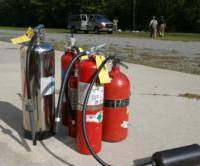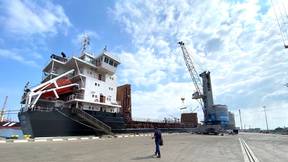Incorrectly Installed Fuel Tubing Led to Containership Fire Off California -NTSB
An incorrectly installed section of main engine fuel oil return tubing led to an engine room fire aboard a containership off the coast of Santa Barbara, Calif., the National Transportation Safety Board (NTSB) said Tuesday.Marine Investigation Report 22/15 details the NTSB’s investigation of the April 28, 2021, fire aboard the containership President Eisenhower while transiting through the Santa Barbara Channel. The vessel was transiting to Oakland, California with a crew of 22. The crew extinguished the fire using the engine room’s fixed carbon dioxide fire-extinguishing system. As a result of the fire, the vessel lost propulsion and drifted for several hours before being towed to the Port of Los Angeles. No pollution or injuries were reported.
Thome Signs Safety Service Agreement with WSS

Singapore-based Thome have signed a Safety Service agreement with Wilhelmsen Ships Service (WSS). Harald Lundestad, General Manager for WSS in Singapore said: “Companies such as Thome have to balance the logistical demands of managing a large and diverse fleet trading worldwide with the challenge of keeping vessels compliant. WSS safety service technicians carry out services on a wide range of safety, firefighting and rescue equipment such as CO2 high-pressure systems, portable fire extinguishers…
Is Your Crew Really Prepared?

If you think training is expensive; try ignorance. In the ensuing years following the Exxon Valdez disaster, the maritime industry has made great strides in training mariners to prepare for, respond to and mitigate a multitude of emergencies aboard vessels. For example, the environmental performance of the marine industry itself has all but eliminated much of the oil that formerly entered the water through marine error or equipment failures. Nevertheless, the incidents with vessels that do occur, large and small, bring into question the effectiveness of the training.
Safety in Numbers

The U.S. Department of Labor’s Occupational Safety and Health Administration (OSHA) recently cited a shipyard for 61 alleged violations of workplace safety and health standards. Faced with $293,450 in proposed fines, the shipyard’s alleged violations include electrical hazards, such as failure to guard lights from damage, failure to provide effective electrical grounding for equipment, failure to provide covers on electrical box openings, and failure to ensure wiring was protected from abrasion and strain.
Ten Most Frequently Observed Towing Vessel Deficiencies
The U.S. Coast Guard’s Towing Vessel National Center of Expertise (NCOE) recently conducted an analysis of all deficiencies recorded by CG field personnel while Examining “uninspected towing vessels” (UTV) under the Towing Vessel Bridging Program and through other activities. The purpose of this analysis was to provide information and visibility on the most common UTV deficiencies list to share with UTV owner/operators in order to assist them in identifying and correcting common problems. In May of this year, they issued a comprehensive list that workboat operators – no matter what sector in which they operate – will find enormously helpful.
Statutory Alert: Revised IMO Guidelines for Maintenance
Revised IMO guidelines for maintenance, testing and inspection of fire protection systems and appliances will become effective on May 31, 2013 and are contained in the circular MSC.1/Circ. 1432. These guidelines should be followed in accordance with SOLAS regulation II-2/14, which requires that all fire protection systems and appliances are kept in good order and that a maintenance plan is developed. The guidelines state that certain maintenance procedures and inspections may be performed by competent crew members who have completed an advanced fire-fighting training course, while others should be performed by people specially trained in the maintenance of such systems.
USCG and CMTI Warn of Counterfeit Fire Extinguishers

Beware of counterfeit U.S. Coast Guard-approved portable fire extinguishers. The U.S. Coast Guard announced that it was made aware of counterfeit extinguishers said to be manufactured by Amerex Corporation and Buckeye Fish Equipment. “Both companies are major producers of genuine approved fire extinguishing equipment,” the U.S. Coast Guard said in a marine safety alert issued in March 2013. “Counterfeit portable fire extinguishers pose a safety hazard for any vessel that has one on board,” said Chesapeake Marine Training Institute’s President and Founder, Capt. Guy Sorensen.
NTSB: Faulty Fuel-Injection to Blame for 2004 Fire
The National Transportation Safety Board determined that the probable cause of the fire on board the Shuttle Express II was a fractured, improperly installed fuel-injection line on the inboard side of the starboard engine that allowed diesel fuel to spray onto the engine and ignite. Contributing to the cause of the fire was the failure of Paradise of Port Richey, the operator of the vessel, to have a preventive maintenance program, which could have identified the company's ongoing problems with the vessel's fuel lines before the failed line led to the fire. "Proper training on the replacement of the fuel line would have prevented this fire, which could have endangered the lives of the passengers who had just departed the boat minutes earlier," said Mark V. the NTSB.
USCG Issues Fire Protection Equipment Requirements
All towing vessels except those in restricted services are required to comply with new requirements for fire protection equipment and procedures under an interim rule issued by the USCG. The rule is the first step in a two-pronged approach to implementing the requirements of the 1996 USCG Authorization Act, which directed the USCG to promulgate regulations requiring fire suppression systems or other measures to control fires on towing vessels. · An engine room fire detection system with visible and audible alarms. · A fixed or portable system allowing for two-way communication between the pilothouse and the engine room. · A remote fuel shutoff for the main engine and other fuel lines.
Fire Safety Training: Up Close
It was hot. Really hot, the smoke was getting denser by the moment as the fire grew larger. It was getting darker. I couldn't see the flames any more from my position on the hose line but I could certainly feel the heat. "Here it comes," announced Todd Duke, the instructor leading my team into hell. All of a sudden the compartment lit up as a ball of flames raced across the overhead. The heat was intense. Two quick bursts from the nozzle, more darkness. The steam created made an evil hissing noise. I had just experienced my first flashover. I was beginning to wonder why I had chosen this line of work. Our instructor is telling us this is what we don't want to happen onboard our vessels. The overhead flashes over again. Two more bursts of water.








